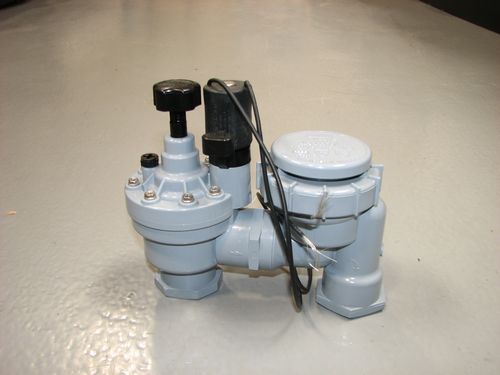Irrigation Product Listings & Reviews
Irritrol 2700 Series Anti-Siphon Valves Lawn Genie model L7010 & L7034 & RJ 54000 Anti-Siphon Valves

Irritrol model 2713APR Anti-Siphon Valve.
Description:
The 2711 and 2713 are very popular residential anti-siphon valves with a built-in backflow preventer (atmospheric vacuum breaker). They are also sold under the Lawn Genie brand as models L7010, L7034, & RJ 54000.
Model Numbers:
- 2711APR -- 3/4" electric anti-siphon valve with flow control handle
- 2713APR -- 1" electric anti-siphon valve with flow control handle
- 2711DPR -- 3/4" electric anti-siphon valve with flow control screw
- 2713DPR -- 1" electric anti-siphon valve with flow control screw
- L7010 -- Lawn Genie 3/4" electric anti-siphon valve with flow control screw
- L7034 -- Lawn Genie 1" electric anti-siphon valve with flow control screw
- RJ 3/4 54000 -- Lawn Genie 3/4" electric anti-siphon valve with flow control handle
Features:
- Double-beaded SANTOPRENE® diaphragm.
- Buna-N valve seat seal.
- Manual internal bleed
- Manual external bleed (flush mode)
- Full stainless steel metering system
- Flow control allows precise flow adjustment and manual shut-off
- Gravity-type anti-siphon poppet
- UV-resistant PVC, glass-filled polypropylene and stainless steel construction
- Encapsulated injection-molded solenoid
- Captive hex plunger
- Easily serviced without removal from system
- Meets listing standards of ASSE, IAPMO and CSA when properly installed.
- Flow range: 0.25-30 GPM
- Pressure range: 10-150 PSI
APR Models:
- Captured hex/Phillips screws
- Removable flow control handle
- Self-aligning bonnet permits fast and easy servicing
- High-strength ribbed bonnet
- Patent pending floating metering system
DPR Models and Lawn Genie:
- Threaded bonnet system permits fast and easy servicing
- Patented, tamper-resistant flow control mechanism
Manufacturer's Performance Data:
| Size | 0.25 GPM | 2 GPM | 5 GPM | 10 GPM | 15 GPM | 20 GPM | 30 GPM |
| 3/4" | 5.0 PSI | 5.8 PSI | 4.14 PSI | 4.11 PSI | 4.72 PSI | 7.6 PSI | Don't Use |
| 1" | 5.0 PSI | 5.5 PSI | 2.03 PSI | 3.10 PSI | 2.22 PSI | 3.72 PSI | 8.01 PSI |
Note: Use the pressure loss to determine the size of valve you need. It is common for the valve to be a size smaller than the pipe it is installed on.
Review:
This is an extremely popular valve that has been made for many, many years with only minor changes to the design. Available in 3/4" and 1" sizes. The internal bleed feature means it doesn't spit water out the side of the valve when operated manually. The captive plunger makes it easier to work on, the plunger is locked in the solenoid so it won't fall out if the solenoid is removed. The valve can be repaired without removing it from the piping (unless the body breaks.) The APR model has a flow control handle, the DPR has a flow control screw. The DPR series are the same valves as the Lawn Genie model L701 & L703. The 2711APR is the same as the Lawn Genie RJ 3/4 54000.
A good quality, inexpensive valve that has been sold for many years under the Lawn Genie, and formerly under the Richdel brand name. This valve has been installed at millions of homes in the Western USA. As with all plastic equipment I recommend it be protected from direct sunlight. I have experienced problems with the flow control adjustment screw and the manual bleed screws breaking. I recommend avoiding these two models. The Irritrol APR model is a good choice for a residential system where a anti-siphon valve is appropriate (see below). These anti-siphon valves have a built in atmospheric backflow preventer.
Important Installation Rules:
These rules apply to all brands and models of anti-siphon valves!
The bottom of the valve MUST be installed so that it is 6 inches higher than any of the sprinkler heads or drip emitters it operates. That means that in most cases it must be installed on pipes above ground. An anti-siphon valve may not be installed below ground level or at any location where it might become submerged (for example it can't be underground in a valve box.) If the yard is sloped, it usually needs to be at the highest point in the yard. Run a mainline from the water source to the highest point of the yard. Install the anti-siphon valves above ground at that location, then run pipe from the anti-siphon valves to the sprinklers or emitters. If the sprinklers or emitters are higher than the anti-siphon valve the backflow preventer part of the valve will not work and the installation is considered illegal! If the sprinklers or emitters are not 6" below the anti-siphon valve water will run out of the anti-siphon vents on the valve when it is turned off. More than a tablespoon or two of water running out of the anti-siphon valve vent almost always means the valve is not properly installed.
Do not install any other valve, manual or automatic, on the pipe downstream of the anti-siphon valve. This applies to all brands of anti-siphon valves. I have heard numerous salesmen and contractors tell potential customers that this will work, and THEY ARE WRONG! The backflow preventer in the anti-siphon valve will not work if another valve is installed after it. What this means is that you may not use a single anti-siphon valve as a backflow preventer for a group of standard valves. If you decide to use anti-siphon valves, every valve you use must be a anti-siphon valve and every one of them must be installed 6 inches higher than the sprinklers or emitters they operate. For more in-depth information on backflow preventers, see the backflow preventer page.